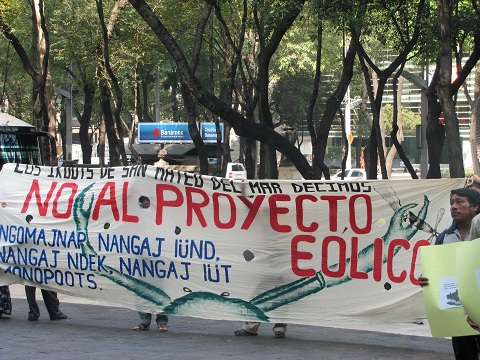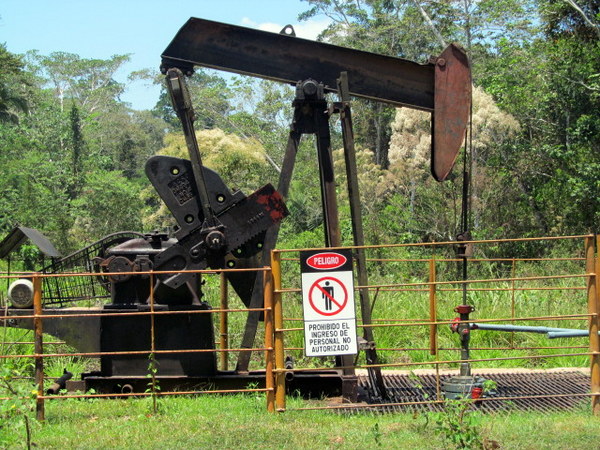
Indigenous people in Mexico organizing resistance against corporate wind farms
By Jennifer M. Smith / Upside-Down World
More than five centuries after Colombus’ arrival in the Americas, the invasion of European powers continues to threaten traditional ways of life in indigenous communities in Mexico. The conflict against the corporate takeover of the ancestral lands of the Huave, or Ikoots people, in the Isthmus of Tehuantepec in Oaxaca is just one of the struggles continuously being played out in the face of trans-national development policies such as Plan Puebla Panama (now known as Proyecto Mesoamerica).
The Ikoots people of Oaxaca have inhabited the Isthmus of Tehuantepec for more than 3000 years, pre-dating the better-known Zapotec culture in Oaxaca. They are a fishing society that depends on the ocean for their livelihood; the Ikoots peoples’ history is so integrated with the sea that they are also known as Mareños (“Oceaners”). Now Ikoots communities are struggling to defend their ancestral lands from multinational corporations who want to build wind turbines in the water along the coast, in the very ocean that has supported their way of life for centuries.
In April of 2004, the United States Department of Energy (DOE) and the US Agency for International Development (USAID) sponsored a study to accelerate the development of wind projects in the state of Oaxaca, which found that the best area for wind project development was in the Isthmus of Tehuantepec, in the heart of the ancestral Ikoots territory. [1]
The proposed Parque Eolico San Dionisio (San Dionisio Wind Park), a wind farm to be constructed in the ocean along the coast, would consist of 102 wind turbines in the water outside the town of San Dionisio del Mar (and 30 more outside neighboring Santa Maria del Mar), two electric transformer substations, six access paths and additional support structures. [2] It would take up 27 kilometers of coastline. The multinationals implementing the project have also informed the Mexican government that they will need to install 5 mooring docks in the Laguna Superior, a coastal lagoon that local communities heavily depend on for fishing. [3]
The construction of wind turbines would have a devastating effect on both Ikoots society and the environment. The community fears that the vibration from the machines would destroy the aquatic life in the area, which is the economic basis of survival for Ikoots communities such as San Dionisio del Mar, San Mateo del Mar and San Francisco del Mar.
“This is the life of the poor: we fish so we can eat and have something to sell, to have a bit of money. They say that now that the wind project is here, they’ll give us money for our land and sea, but the money won’t last forever. We don’t agree with this. How are we going to live?” says Laura Celaya Altamirano, a resident of Isla Pueblo Viejo and the wife of a fisherman. [4] The wind turbines also present a threat to migratory birds and would damage the ecosystems of the local mangrove swamps. In addition, the proposed construction would desecrate Ikoots sacred territory, namely the Isla de San Dionisio and the Barra de Santa Teresa (known by the Ikoots communities as Tileme).
The proposed location for the aquatic wind farm is San Dionisio del Mar, a town of about 5000 residents. The project in San Dionisio is being implemented by a consortium called Mareña Renovable, which consists of the global investment bank Macquarie, based in Australia; the Dutch investment group PGGM; and the Mitsubishi Corporation of Japan. It includes turbines constructed by the Danish Company Vestas Wind Systems, and the involvement of two wind power companies: Grupo Preneal of Spain, and DEMEX of Mexico. The project also has funding from the Inter-American Development Bank. [5] The electricity from the farm would be used to power such corporate giants as FEMSA (based in Mexico, the largest beverage company in Latin America), Coca-Cola, Heineken, and other multinational corporations. [6]
A total disregard for the environment and the livelihoods of local people is par for the course when multinationals step in to take over communal lands for profit. In the Isthmus of Tehuantepec, wind power companies have been exploiting local communities for years, pressuring farmers (most with little formal education) to sign contracts they often don’t understand in order to give up their rights to land that has been held communally for generations. “Oaxaca is the center of communal landownership. There is probably no worse place to make a land deal in Mexico,” says Ben Cokelet, founder of the Project on Organizing, Development, Education, and Research.[7]
Developers held meetings with locals in which model windmills the size of dinner platters were shown; they were led to believe they could continue farming around them. Later they were shocked to see 15-to-20-story turbines constructed, taking up acres of their land. Developers pay the farmers a pittance in exchange for their land, often paying only 1/5th of what they would pay for similar land in the US, or 1/7thof what they would pay the Mexican government for the same land.
And, in a move that exacerbates tension in the community, local leaders are given better deals for their land in order to make the process more appealing to the rest of the population: “The first guy or two that bites gets [$8] per square meter. That’s a hundred times better contract than the other people,” says Cokelet. “But the 98 percent of farmers who sign afterwards sign on for rock-bottom prices. Those one or two people who bite – they don’t bite because they’re lucky. They bite because they know someone. And their job … is to sell it to all their neighbors.” [8]
There are currently 14 wind farms built on land in the Isthmus of Tehuantepec, with 4 under construction in 2012 and 3 more scheduled for 2013. [9] According to the Declaración de San Dionisio del Mar, released on September 17 by the indigenous rights organization UCIZONI (La Unión de Comunidades de la Zona Norte del Istmo – The Union of Communities in the North Zone of the Isthmus), the communities affected by the 14 existing wind farms have not benefited from lower electricity rates; rather, the intention of the farms is clearly to serve the interests of transnational corporations such as Coca-Cola, Walmart, Nestle, Bimbo and others. [10]
The wind turbines in San Dionisio are the first proposed turbines to be built in the sea. Ikoots communities would not even benefit from the jobs created by the wind turbines; the construction and maintenance of the wind turbines would most certainly be given to employees of the multinational corporations funding the project, not to local fishermen.
The Ikoots community of San Dionisio del Mar did not consent to this project, nor were they even informed that it was under consideration. The International Labour Organization, a United Nations agency dealing with labor rights, specifically states in its Convention 169 (Convention on Indigenous and Tribal Peoples) that “special measures… be adopted to safeguard the persons, institutions, property, labour, cultures and environment of these [indigenous] peoples. In addition, the Convention stipulates that these special measures should not go against the free wishes of indigenous peoples.” Mexico ratified this convention in 1990. [11] In this case, there was no public forum or announcement regarding the construction of the wind farms.
“A common practice of foreign businesses is to ‘buy’ [via bribes] the local PRIista authorities,” says Carlos Beas Torres, a leader and co-founder of UCIZONI and a well-known activist for indigenous rights. In 2004, Alvaro Sosa, the then-president of the “comisariado de bienes comunales” (essentially, the commissary for the territory held in common by the community), signed a preliminary contract renting a section of land to the Spanish corporation Preneal without the knowledge of the town’s residents. The 30-year contract that gave the multinationals access to 1643 hectares of land; Sosa did not inform the community of this action and accepted bribes in exchange for his consent.[12]
The people of San Dionisio del Mar did not find out about the existence of this contract until late in 2011, when the municipal president, Miguel López Castellanos (a member of the Partido Revolucionario Institucional, or PRI), again without consulting the community gave his permission for the consortium Mareña Renovables to begin construction of wind turbines in exchange for a payment of between 14-20 million pesos (between $1-1.5 million USD). The multinationals claim to have given him 20 million pesos, but Lopez Castellanos only admits to receiving 14 million pesos. [13]
Upon this discovery, the residents of San Dionisio held a public assembly where they demanded that the municipal president revoke his consent for the wind farm, which he refused to do. In February, representatives from the community met with DEMEX in Mexico City to request that the contract process start over, but were turned down. [14] Thus the struggle for control of the Ikoots’ ancestral land began.
Not surprisingly, an intense resistance movement against the wind farm has surged in San Dionisio del Mar. The townspeople have initiated a legal battle in the Tribunal Unitario Agrario (Agrarian Unitary Tribunal), the government agency in charge of settling agrarian disputes, in an attempt to nullify the contract. However they are also taking direct action in an attempt to defend their land.
In late January 2012, community members took possession of the municipal palace in San Dionisio in protest, ejecting municipal president Miguel López Castellanos, creating the Asamblea General del Pueblo de San Dionisio (General Assembly of the People of San Dionisio), and declaring themselves in resistance.[15] In April, the San Dionisio communal assembly prevented employees of the multinationals from laying out access roads in the Barra de Santa Teresa, and set up a permanent watch to make sure the contractors do not return. [16]
In September, community members organized a national encuentro (or gathering) in San Dionisio, with the participation of around 300 people from 25 different indigenous and activist organizations from 6 different states in Mexico.[17] The intent of the encuentro was not only to raise awareness on what was happening on Ikoots land, but also to create a large-scale national plan of action to resist megaprojects such as the wind farms. “It’s practically a second Spanish Conquest; they’re coming again to snatch our land with a contract that is completely advantageous, draconian and in violation of our rights as indigenous people,” says Jesús García Sosa, a representative of the Asamblea General. [18]
The resistance movement continues to grow despite threats and intimidation, as well as actual physical attacks on community members committed by opposing political factions. The general consensus is that these factions are being paid by the multinationals involved to hamper resistance to the development project. On August 25, a representative of the Asamblea General named Moisés Juárez Muriel was brutally attacked while walking home in the evening by two men who beat him with stones.
He was taken by two compañeros in resistance to the IMSS-Complamar clinic, where he was refused treatment because the clinic was under control of the municipal president. [19] In mid-September, immediately after the conclusion of the encuentro in support of the Ikoots community members in resistance, a group of heavily armed individuals surrounded the municipal palace that the community members were occupying, pointing guns at and intimidating the people who were guarding the building. [20]
Resistance movement leaders have also received public death threats from political parties and anonymous sources. On October 6, a group of PRI agitators marched through San Dionisio, making specific death threats against Bettina Cruz Velazquez, a well-known human rights activist and founder of the Asamblea de los Pueblos Indígenas del Istmo de Tehuantepec en Defensa de la Tierra y el Territorio (Assembly of Indigenous Peoples of the Isthmus of Tehuantepec in Defense of Land and Territory).
Cruz Velazquez is deeply involved in the resistance movement against the wind project. Human rights groups in Mexico have formally asked the governor of Oaxaca, Gabino Cué Monteagudo, to guarantee her safety. [21] Carlos Beas Torres of UCIZONI has received threatening phone calls for his public stance in opposition of the project. [22]
In some cases, attempts to stop resistance support have led to clashes. In mid-October, two organizations, El Frente por la Defensa de la Tierra (The Front for the Defense of the Earth) and UCIZONI sent a caravan of support attempting to bring food and supplies to the community in resistance in San Dionisio. A blockade was set up by armed PRIista sympathizers of the municipal president, Miguel López Castellanos, to keep the caravan from passing. [23] A violent confrontation ensued.
“The store owners in San Dionisio belong to the PRI and refuse to sell food to the people resisting the wind project,” says Carlos Alberto Ocaña, whose father (a native of San Dionisio) was the driver of the first truck in the supply caravan. “When the caravan approached the town, it was stopped by a blockade of about 70 people. They had guns, machetes, and gasoline for setting the cars on fire. My father was in the first truck with five other people. They PRIistas in the blockade pulled them out of the truck and started beating them.”
The police eventually arrived, but the caravan was unable to pass the barricade to reach San Dionisio and eventually it was forced to turn back without delivering the supplies.
On October 17 and 18, members of the Asamblea General of San Dionisio, UCIZONI, la Asamblea de Pueblos Indígenas del Istmo en Defensa de la Tierra y el Territorio, la Alianza Mexicana por la Autodeterminación de los Pueblos (Mexican Allaince for the Self-Determination of the People, AMAP), and a half dozen other groups held protests in Mexico City. They held rallies in front of the Interamerican Development Bank, Mitsubishi, Coca-Cola, Vestas, and the Danish embassy. Their goal was twofold: to impede the construction of the wind park in San Dionisio, but also to publicly denounce the environmental and cultural damage that threatens the Ikoots communities of the Isthmus.
They were received and allowed to present written complaints at the Interamerican Development Bank, Vestas, and the Danish embassy. oca-Cola-FEMSA refused to meet with them. [24] As of this writing, the Ikoots communities’ struggle against corporate takeover continues; in November representatives of the community will travel to the Netherlands, with the support of Dutch unions, to present a letter of protest in person to the Dutch investment company PGGM.
In the words of Asamblea General representative Jesús García Sosa, “We will not allow that business and government to yet again displace us from our territory, which symbolizes our very life, our mother, our father; we can’t sell it to them or put a price on it, much less in exchange for projects of death and plunder.” [25]
On October 30th, President Felipe Calderon Hinojosa, who was in Oaxaca to inaugurate a new highway, also travelled to inaugurate the Piedra Larga Wind Park. Calderon saluted the project, citing it as a solution to poverty and climate change, and mentioning the “additional income” the residents of the town Unión Hidalgo would receive for allowing the turbines to be installed on their communal land.
Meanwhile, 300 meters outside the park, theirn entrance blocked by national police, nearly 200 people from different communities in the region including San Mateo del Mar, San Dionisio del Mar, San Francisco del Mar, Unión Hidalgo, Juchitán, Santa María Xadani and the UCIZONI, protested the park’s opening. [26]
1. Noticias de Oaxaca, Oct. 14 2012.
2. Noticias de Oaxaca, Aug. 20 2012.
3. Noticias de Oaxaca, Apr. 21 2012.
4. Noticias de Oaxaca, Aug. 20 2012.
5. Recharge News, Mar. 12 2012.
6. Noticias de Oaxaca, Apr. 23 2012.
7. Christian Science Monitor, Jan. 26 2012.
8. Ibid
9. Noticias de Oaxaca, Oct. 11 2012.
10. UCIZONI statement, Sept. 17 2012.
11. International Labor Organization Convention 169.
13. Noticias de Oaxaca, Aug. 20 2012.
14. Christian Science Monitor, Feb. 28 2012.
15. El Sol del Istmo, Jan. 30 2012.
16. Noticias de Oaxaca, Apr. 21 2012.
17. Despertar de Oaxaca, Sept. 28 2012.
18. Noticias de Oaxaca, Aug. 20 2012.
19. Quadratin Oaxaca, Oct. 9 2012.
20. Ibid.
21. E-Oaxaca, Oct. 15 2012.
22. Quadratin Oaxaca, Oct. 9 2012
23. E-Oaxaca, Oct. 11 2012. (Link at e-oaxaca.mx/noticias/nacional/13411-impide-edil-de-san-dionisio-del-mar-ingreso-de-caravana-contra-empresas-eolicas.html no longer works)
24. La Jornada, Oct. 17 2012:
25. Noticias de Oaxaca, Aug. 20 2012.
26. Eco Noticias Huatulco. Oct 30, 2012.
From Upside Down World: http://upsidedownworld.org/main/mexico-archives-79/3952-indigenous-communities-in-mexico-fight-corporate-wind-farms


